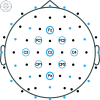Comparing MEG and EEG measurement set-ups for a brain-computer interface based on selective auditory attention
- PMID: 40209163
- PMCID: PMC11984968
- DOI: 10.1371/journal.pone.0319328
Comparing MEG and EEG measurement set-ups for a brain-computer interface based on selective auditory attention
Abstract
Auditory attention modulates auditory evoked responses to target vs. non-target sounds in electro- and magnetoencephalographic (EEG/MEG) recordings. Employing whole-scalp MEG recordings and offline classification algorithms has been shown to enable high accuracy in tracking the target of auditory attention. Here, we investigated the decrease in accuracy when moving from the whole-scalp MEG to lower channel count EEG recordings and when training the classifier only from the initial or middle part of the recording instead of extracting training trials throughout the recording. To this end, we recorded simultaneous MEG (306 channels) and EEG (64 channels) in 18 healthy volunteers while presented with concurrent streams of spoken "Yes"/"No" words and instructed to attend to one of them. We then trained support vector machine classifiers to predict the target of attention from unaveraged trials of MEG/EEG. Classifiers were trained on 204 MEG gradiometers or on EEG with 64, 30, nine or three channels with trials extracted randomly across or only from the beginning of the recording. The highest classification accuracy, 73.2% on average across the participants for one-second trials, was obtained with MEG when the training trials were randomly extracted throughout the recording. With EEG, the accuracy was 69%, 69%, 66%, and 61% when using 64, 30, nine, and three channels, respectively. When training the classifiers with the same amount of data but extracted only from the beginning of the recording, the accuracy dropped by 11%-units on average, causing the result from the three-channel EEG to fall below the chance level. The combination of five consecutive trials partially compensated for this drop such that it was one to 5%-units. Although moving from whole-scalp MEG to EEG reduces classification accuracy, usable auditory-attention-based brain-computer interfaces can be implemented with a small set of optimally placed EEG channels.
Copyright: © 2025 Kurmanavičiūtė et al. This is an open access article distributed under the terms of the Creative Commons Attribution License, which permits unrestricted use, distribution, and reproduction in any medium, provided the original author and source are credited.
Conflict of interest statement
The authors have declared that no competing interests exist.
Figures




Similar articles
-
Target of selective auditory attention can be robustly followed with MEG.Sci Rep. 2023 Jul 6;13(1):10959. doi: 10.1038/s41598-023-37959-4. Sci Rep. 2023. PMID: 37414861 Free PMC article.
-
Reliable measurement of auditory-driven gamma synchrony with a single EEG electrode: A simultaneous EEG-MEG study.Neuroimage. 2024 Oct 15;300:120862. doi: 10.1016/j.neuroimage.2024.120862. Epub 2024 Sep 19. Neuroimage. 2024. PMID: 39305968
-
Sensitivity of EEG and MEG to the N1 and P2 auditory evoked responses modulated by spectral complexity of sounds.Brain Topogr. 2007 Winter;20(2):55-61. doi: 10.1007/s10548-007-0031-4. Epub 2007 Sep 25. Brain Topogr. 2007. PMID: 17899352 Free PMC article.
-
Electromagnetic recording of the auditory system.Handb Clin Neurol. 2015;129:245-55. doi: 10.1016/B978-0-444-62630-1.00014-7. Handb Clin Neurol. 2015. PMID: 25726273 Review.
-
Electroencephalography and Magnetoencephalography.2023 Jul 23. In: Colliot O, editor. Machine Learning for Brain Disorders [Internet]. New York, NY: Humana; 2023. Chapter 9. 2023 Jul 23. In: Colliot O, editor. Machine Learning for Brain Disorders [Internet]. New York, NY: Humana; 2023. Chapter 9. PMID: 37988523 Free Books & Documents. Review.
References
-
- Cherry EC. Some experiments on the recognition of speech, with one and with two ears. J Acoust Soc Am. 1953;25(5):975–79.
-
- Woldorff MG, Gallen CC, Hampson SA, Hillyard SA, Pantev C, Sobel D. Modulation of early sensory processing in human auditory cortex during auditory selective attention. Proc Natl Acad Sci USA 1993;90(18):8722–6. https://pnas.org/doi/full/10.1073/pnas.90.18.8722 - DOI - PMC - PubMed
-
- Bronkhorst AW. The cocktail-party problem revisited: early processing and selection of multi-talker speech. Atten. Percept. Psychophys 2015;77(5):1465–87. https://www.ncbi.nlm.nih.gov/pmc/articles/PMC4469089/ - PMC - PubMed
-
- Fritz JB, Elhilali M, David SV, Shamma SA. Auditory attention—focusing the searchlight on sound. Curr Opin Neurobiol 2007;17(4):437–55. https://linkinghub.elsevier.com/retrieve/pii/S0959438807000943 - PubMed
-
- Hillyard SA, Hink RF, Schwent VL, Picton TW. Electrical signs of selective attention in the human brain. Science 1973;182(4108):177–80. https://www.science.org/doi/10.1126/science.182.4108.177 - DOI - PubMed
Publication types
MeSH terms
LinkOut - more resources
Full Text Sources

